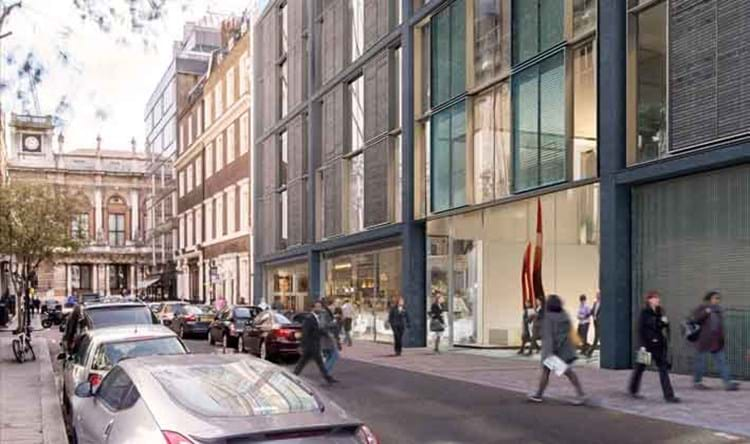
As part of that permission, the scheme at 22-27 Cork Street in London's West End is subject to a legal agreement so that "at least five galleries will be present at all times" at the site and an arcade will be created from Cork Street to Old Burlington Street.
However, such support has come too late for the existing on-site galleries who now have to look for new premises and fear that rents for the larger spaces in the new development will be much higher, meaning smaller, independent galleries who take risks on little-known artists and give the area its character will be priced out.
Westminster City Council also say a Special Policy Area (SPA) could be brought in later this year "to further protect the area" and create an "arts quarter in the centre of London".
Campaigners from the Save Cork Street group say the proposed SPA "will not be in time to be able to save the existing galleries". In a statement after the planning decision, they said: "For nearly 100 years Cork Street has been recognised as one of the most important, if not the most important street in the world for art.
"It has launched more careers in the art world than any other street - names such as Lucian Freud, Francis Bacon, Sir Peter Blake, Lynn Chadwick, David Hockney, and the list goes on and on. The small independent dealers mean diversity and they are able to take risks, presenting emerging artists. Larger galleries, with the costs of Mayfair, mean that they will be dealing with only the branded names in the art world and not championing the emerging artists."
Artistic Heritage
One of those affected, the Mayor Gallery, was the first to open its doors in Cork Street, founded by Fred Mayor in 1925. Many artists exhibited for the first time in England at the gallery and included Bacon, Calder, Ernst, Klee, Masson, Miró and Paolozzi. The gallery was also the centre of UNIT ONE, a group that included Henry Moore, Ben Nicholson, Paul Nash, Edward Wadsworth, Edward Burra and others.
Waterhouse & Dodd, at no.26, have already announced they are moving to nearby Albemarle Street. Reports suggest that Gary Snell, owner of the Alpha Gallery, has decided to move his business abroad because of the lack of affordable space in Mayfair, although this has not been confirmed.
Some of the galleries had launched a legal challenge to the plans under the Landlord and Tenant Act 1954 but this was eventually dropped.
A Westminster spokesman said: "The legal agreement will restrict a certain amount of the new retail floorspace (equivalent to the same amount of retail floorspace that currently exists on the site) for use as art/antique gallery/shop purposes only.
"Retail use falls within Class A1 of the Use Classes Order and normally there are no planning restrictions preventing one type of shop from changing to another. In planning terms there is nothing to prevent the existing galleries from changing to another type of shop.
"Normally there would be no restriction on the type of shop that would occupy the new retail floorspace. For that reason, securing the replacement gallery use in the development, to protect Cork Street's character and function as a centre for art galleries, is a major planning benefit."
He added: "There is no protection for the existing gallery operators - only definite provision in the Native Land scheme for art gallery space, and for it to be a minimum of five shop units at ground-floor level.
"Rent levels and offering the existing galleries the chance to take space in the new arcade is beyond planning's remit."
Five SPAs already exist in Westminster, including one covering St James's for 'Specialist Retail/Private Members clubs/Art Galleries'. The SPA "in practice will give more planning policy weight to protect art gallery floorspace that will be threatened by redevelopments".
"We will be launching a consultation at the end of September which will run for eight weeks, and look at two things - the suggested boundaries and the wording of the policy. So we have yet to determine exactly the streets, though clearly the focus is going to be on the concentrations of galleries around Cork Street," the spokesman added.
As part of the agreement, "young artists from local colleges will also have the opportunity to display their own work in cases in the new arcade".
New Space
A spokesman for the developer, Native Land, said the galleries at 22-27 would have the opportunity to talk to them about taking new space when it became available on the market. No guarantees had been given to provide units to them in the new scheme.
Alasdair Nicholls, chief executive of Native Land, said: "These proposals will greatly enhance Cork Street and the experience of visiting one of London's most established art gallery districts, by both augmenting the gallery offering of the building and creating an arcade with a permanent dedicated space for young and emerging artists."
Another development affecting five of the 22 galleries in Cork Street, at Nos.5-9, by Pollen Estates, has been given conditional permission provided a section 106 legal agreement being drawn up secures "a minimum of 1,727 sq m of the new retail accommodation" to be occupied "for art or antique gallery/shop purposes, at a market rent for art gallery/antique shop use (final definition to be agreed)".




